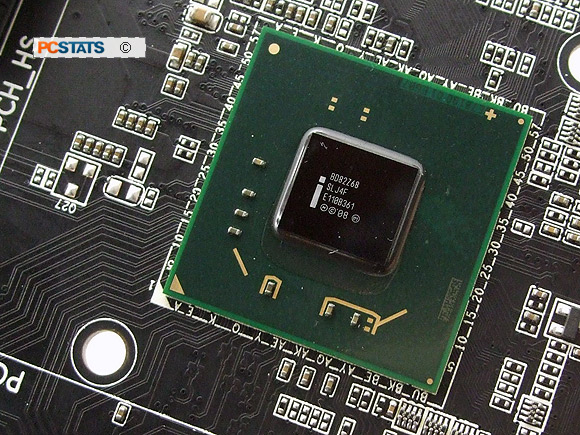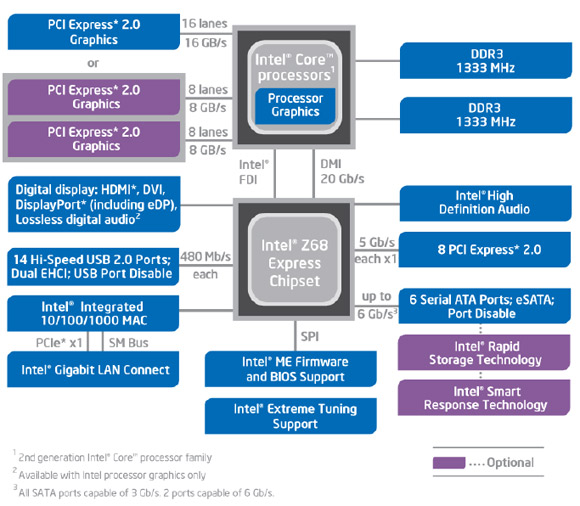
|
Socket 1155 motherboards like the Gigabyte GA-Z68X-UD3H-B3 which are built around it offer up a mainstream suite of capabilities and a kitchen sink full o'features. The board
supports 2nd Generation Intel Core i3/i5/i7 2xxx-series socket LGA1155
processors - these CPUs are based on the Intel 'SandyBridge'
architecture which includes an integrated graphics core on the CPU
die.
88% Rating: 
|
|
|
|
Home >
Reviews >
Motherboards >
Gigabyte GA-Z68X-UD3H-B3 |
|
|
Intel Z68 Express Chipset
Intel's Z68 Express chipset has essentially
the same feature set as the Intel P67 and H67 chipsets combined, the notable
new addition being Smart Response Technology.
Intel Smart Response Technology is a
particularly neat solution that brings about like-SSD performance to operating
systems and applications installed on traditional mechanical SATA hard disk
drives (HDD). It works by storing frequently accessed hard drive I/O data blocks
on a small capacity, dedicated 'caching SSD' that Windows 7 can commonly
used data very quickly. See PCSTATS in depth review here for the
full story.
|

The Intel Z68 Express
Chipset
|
Looking
at the block diagram below you'll note that the Intel Z68 PCH communicates
with the socket LGA1155 processor over a DMI link at 20Gb/s and by way of the
Intel FDI (Flexible Display Interface) and hosts eight PCI Express 2.0
lanes running at 5Gb/s. The remaining 16 PCI Express 2.0 lanes needed for
motherboard graphics support are allocated by the processor itself for 16GB/s
total bandwidth.

| Intel Chipset Feature
Comparison |
|
Intel Z68 Express |
Intel P67
Express |
Intel H67
Express |
Intel X58
Express |
| CPU |
LGA 1155
Core i5/i7 2nd Gen. |
LGA 1155
Core i5/i7 2nd Gen. |
LGA 1155
Core i5/i7 2nd Gen. |
LGA 1366
Core i7 |
| Chipset Code Name |
Couger Point (65nm) |
Couger Point (65nm) |
Couger Point (65nm) |
Tylersburg (65nm) |
| Bus Interface / Speed |
DMI 20Gb/s |
DMI 20Gb/s |
DMI 20Gb/s |
QPI 25.6Gb/s |
| Memory Support |
DDR3-1333, dual channel |
DDR3-1333, dual channel |
DDR3-1333, dual channel |
DDR3 1066, triple channel |
| Maximum Memory Capacity |
32GB (64-bit) |
32GB (64-bit) |
32GB (64-bit) |
24GB (64-bit) |
| Integrated Graphics |
Yes. via CPU |
- |
Yes. via CPU |
- |
| Integrated Graphics Ports |
HDMI, DVI, DP, VGA |
- |
HDMI, DVI, DP, VGA |
- |
| PCI Express 2.0 Lanes |
8 |
8 |
8 |
36 |
| PCI Express x1 Lanes |
0 |
0 |
0 |
6 |
| Intel Rapid Storage Technology |
Yes |
Yes |
Yes |
Yes |
| Intel Smart Response Technology |
Yes |
- |
- |
- |
| SATA 6Gb/s | SATA 3Gb/s | IDE Ports |
2/4/0 |
2/4/0 |
2/4/0 |
0/6/0 |
| RAID |
0, 1, 5, 10 |
0, 1, 5, 10 |
0, 1, 5, 10 |
0, 1, 5, 10 (via ICH10R) |
| Intelgrated LAN |
10/100/1000 MAC |
10/100/1000 MAC |
10/100/1000 MAC |
- |
| USB 3.0 Ports |
0 |
0 |
0 |
0 |
| USB 2.0 Ports |
14 |
14 |
14 |
12 |
| PCI Masters |
0 |
0 |
0 |
6 |
| Intel High Definition Audio |
Yes |
Yes |
Yes |
Yes | | |
While
Intel's H67 chipset featured the FDI link so motherboards could rely on the integrated
graphics core within the socket 1155 SandyBridge processor, the Intel P67 chipset did not.
As you can see in
the above Chipset Feature Comparison chart, the Intel Z68 Express chipset makes up for the
shortcomings of the Intel P67 chipset by essentially combining the best
the P67 & H67 chipsets had to offer. With the Intel Z68 chipset you get integrated
graphics, overclocking and video transcoding acceleration via Intel Quick Sync in one package.
Of course integrated graphics are hardly anything to get
excited about if you're a gamer, so this why Lucid's VIRTU driver for the Intel
Z68 chipset is so important....
|
